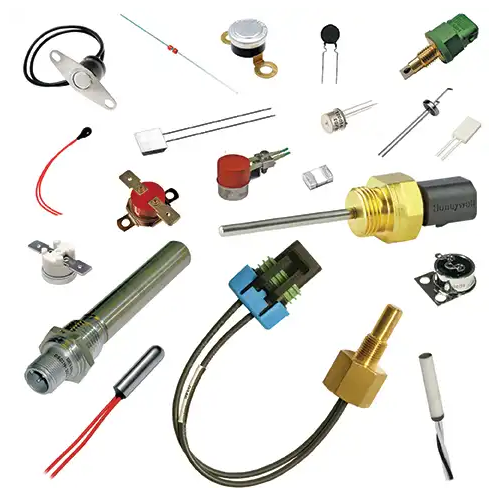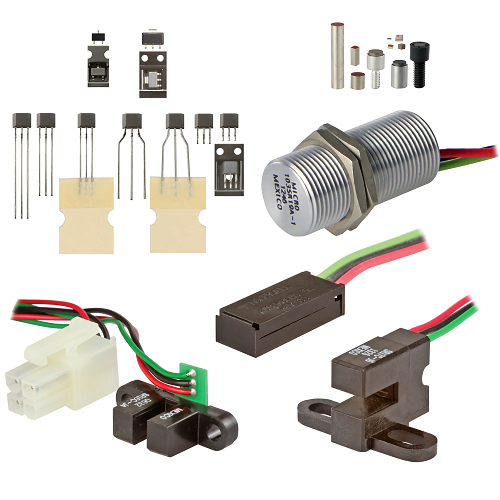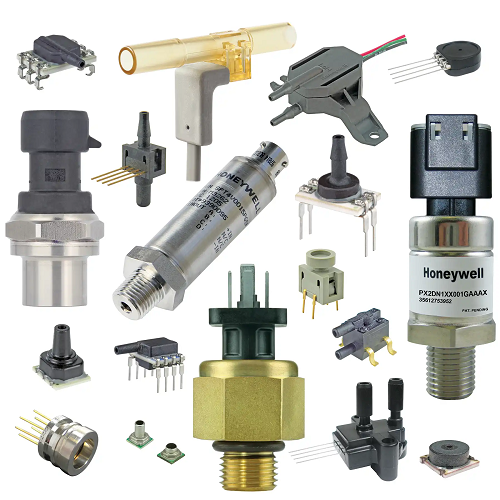Sensors
A sensor is a device that detects and responds to some type of input from the physical environment. Inputs can be light, heat, movement, humidity, pressure, or other environmental factors. Output is usually a signal that is converted to a human-readable sensor location or sent electronically over a network for further reading or processing.
Sourcewell is an authorized distributor of Sensors in India. All Sensors are available in bulk quantities at the best prices here. We also provide sample support and immediate delivery of the products.
Applications:
- Patient Monitoring
- Predictive and preventive
- Industrial applications
- Humidity sensor
Types of Sensor
Air Flow Sensor
Air flow sensors measure the volume or air flow in pipes. The main use of air flow sensors in automobiles is to determine how much air enters the engine from the intake manifold. The airflow sensor is easy to install and measures total pressure, airflow static pressure, and average air velocity.
Barometric Sensor
The barometric pressure sensor is a sensor that detects atmospheric pressure. There are many types of pressure measurement, using different materials and methods, depending on the pressure value to be measured, as shown in the figure below. A sensor that detects atmospheric pressure is called a barometric pressure sensor.
Force Sensor
A force sensor is a type of sensor, specifically a power sensor. It converts electrical energy (such as charge, weight, tension, compression, or pressure) to another variable in the body, in which case the electrical signal can be measured, converted, and designed. As the power applied to the power sensor increases, the electrical signal changes proportionally.
Gas sensor
Gas sensors (also known as gas detectors) are electronic devices that detect and identify various types of gases. They are often used to measure pollution or pollution and measure gas. Gas sensors are used for gas leak detection in factories and factories, smoke and carbon monoxide detection in buildings. Gas sensors differ in size (portable and fixed), range, and sensing capabilities.
Hall Sensors
Hall sensors are designed to detect the Hall effect and convert it into electrical data. The Hall sensor is a sensor that converts the output voltage into a magnetic field. Hall sensors are used in fast sensing, proximity switches, and current sensing applications.
Humidity Sensor
Humidity sensor may be a gadget that recognizes, measures, and reports the relative mugginess of the discuss (RH) or water vapor within the fuel blend (discuss) or unadulterated fuel. Dampness detecting is related to water adsorption and desorption forms. Humidity sensors are utilized for trim checking and farming.
Magnetic Sensors
A magnetic sensor as a rule alludes to a sensor that changes the greatness of the attractive field and its transformation into an electrical signal. The magnetic field, like Soil (geomagnetism) or attraction, could be a wonder but undetectable to the exposed eye. Magnetic sensors that change over undetectable magnetic areas into electrical signals and create unmistakable impacts have been examined for a long time.
Mass Flow Sensor
The airflow meter measures the amount of airflow into the engine. This is important for calculating how much fuel to add to achieve a good air-fuel ratio (AFR) of an ideal 14.7:1 but the AFR will be different.
Oxygen Sensor
The oxygen sensor is a sensor used in the vehicle’s oxygen system. This sensor is large and looks like a spark plug. Depending on its placement relative to the catalytic converter, the sensor can be located in front (top) or behind (bottom) the converter. Most cars produced after 1990 include upper and lower oxygen intakes.
Particle Sensor
Particle sensors are small air sensors that measure airborne particles such as smoke and dust. Inexpensive and easy to operate compared to the, particle sensors have become a popular way to monitor air quality. Although simpler and less accurate than other types of particle monitors, particle sensors can provide important information about air quality, especially when used as part of a sensor network.
Pressure Transducer
Pressure transducer is a device that measures the pressure of a liquid and displays the force that the liquid exerts on the surface it contacts. Pressure sensors are used in many control and monitoring applications, such as flow, air pressure, liquid level, pump, or pressure.
Soil Sensor
Soil moisture sensors measure or estimate the amount of water in the soil. These sensors can be fixed or transported as easily as handheld devices. Soil moisture analyzers can measure soil moisture at different locations when sensors are placed at different locations and depths in the field.
Temperature Sensors
A temperature sensor is an electronic gadget that measures the temperature of its environment and changes over the input data into electronic data to record, screen, or hail temperature changes.
A sensor is a device that detects and responds to some type of input from the physical environment. Inputs can be light, heat, movement, humidity, pressure, or other environmental factors. Output is usually a signal that is converted to a human-readable sensor location or sent electronically over a network for further reading or processing.
Sourcewell is an authorized distributor of Sensors in India. All Sensors are available in bulk quantities at the best prices here. We also provide sample support and immediate delivery of the products.
Applications:
- Patient Monitoring
- Predictive and preventive
- Industrial applications
- Humidity sensor
Types of Sensor
Air Flow Sensor
Air flow sensors measure the volume or air flow in pipes. The main use of air flow sensors in automobiles is to determine how much air enters the engine from the intake manifold. The airflow sensor is easy to install and measures total pressure, airflow static pressure, and average air velocity.
Barometric Sensor
The barometric pressure sensor is a sensor that detects atmospheric pressure. There are many types of pressure measurement, using different materials and methods, depending on the pressure value to be measured, as shown in the figure below. A sensor that detects atmospheric pressure is called a barometric pressure sensor.
Force Sensor
A force sensor is a type of sensor, specifically a power sensor. It converts electrical energy (such as charge, weight, tension, compression, or pressure) to another variable in the body, in which case the electrical signal can be measured, converted, and designed. As the power applied to the power sensor increases, the electrical signal changes proportionally.
Gas sensor
Gas sensors (also known as gas detectors) are electronic devices that detect and identify various types of gases. They are often used to measure pollution or pollution and measure gas. Gas sensors are used for gas leak detection in factories and factories, smoke and carbon monoxide detection in buildings. Gas sensors differ in size (portable and fixed), range, and sensing capabilities.
Hall Sensors
Hall sensors are designed to detect the Hall effect and convert it into electrical data. The Hall sensor is a sensor that converts the output voltage into a magnetic field. Hall sensors are used in fast sensing, proximity switches, and current sensing applications.
Humidity Sensor
Humidity sensor may be a gadget that recognizes, measures, and reports the relative mugginess of the discuss (RH) or water vapor within the fuel blend (discuss) or unadulterated fuel. Dampness detecting is related to water adsorption and desorption forms. Humidity sensors are utilized for trim checking and farming.
Magnetic Sensors
A magnetic sensor as a rule alludes to a sensor that changes the greatness of the attractive field and its transformation into an electrical signal. The magnetic field, like Soil (geomagnetism) or attraction, could be a wonder but undetectable to the exposed eye. Magnetic sensors that change over undetectable magnetic areas into electrical signals and create unmistakable impacts have been examined for a long time.
Mass Flow Sensor
The airflow meter measures the amount of airflow into the engine. This is important for calculating how much fuel to add to achieve a good air-fuel ratio (AFR) of an ideal 14.7:1 but the AFR will be different.
Oxygen Sensor
The oxygen sensor is a sensor used in the vehicle’s oxygen system. This sensor is large and looks like a spark plug. Depending on its placement relative to the catalytic converter, the sensor can be located in front (top) or behind (bottom) the converter. Most cars produced after 1990 include upper and lower oxygen intakes.
Particle Sensor
Particle sensors are small air sensors that measure airborne particles such as smoke and dust. Inexpensive and easy to operate compared to the, particle sensors have become a popular way to monitor air quality. Although simpler and less accurate than other types of particle monitors, particle sensors can provide important information about air quality, especially when used as part of a sensor network.
Pressure Transducer
Pressure transducer is a device that measures the pressure of a liquid and displays the force that the liquid exerts on the surface it contacts. Pressure sensors are used in many control and monitoring applications, such as flow, air pressure, liquid level, pump, or pressure.
Soil Sensor
Soil moisture sensors measure or estimate the amount of water in the soil. These sensors can be fixed or transported as easily as handheld devices. Soil moisture analyzers can measure soil moisture at different locations when sensors are placed at different locations and depths in the field.
Temperature Sensors
A temperature sensor is an electronic gadget that measures the temperature of its environment and changes over the input data into electronic data to record, screen, or hail temperature changes.




















